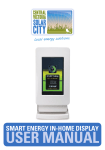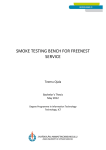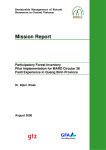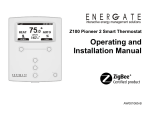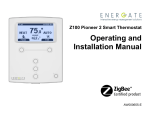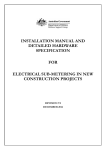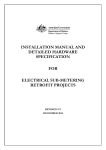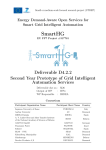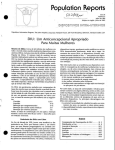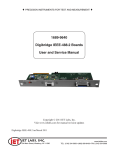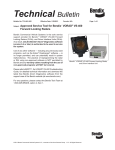Download Demand management of EV charging using Victoria`s
Transcript
Demand management of electric vehicle charging using Victoria’s Smart Grid Demand management of electric vehicle charging using Victoria’s Smart Grid Appendices May 2013 Commercial in Confidence © 2013. All Rights Reserved. DiUS Computing Pty Ltd www.dius.com.au Demand management of electric vehicle charging using Victoria’s Smart Grid Table of contents Appendix A – The case for electric vehicle charging demand management .................................. 3 Appendix B – Victoria’s Smart Grid ........................................................................................................................... 7 Appendix C – ChargeIQ Electric Vehicle home charge management system ............................. 10 Appendix D – Electric Car Driver Guide to Grid-friendly Charging ..................................................... 15 Appendix E – How to Manage Grid-friendly Charging............................................................................... 18 Appendix F – Charge management event schedule ................................................................................... 24 Appendix G – Participant charge management event logs ..................................................................... 25 Appendix H – Participant attitudinal survey ..................................................................................................... 30 Appendix I – Participant attitudinal survey results ....................................................................................... 37 Commercial in Confidence © 2013. All Rights Reserved. DiUS Computing Pty Ltd Demand management of electric vehicle charging using Victoria’s Smart Grid Appendix A – The case for electric vehicle charging demand management Compared to most other uses of electricity in the home, electric vehicles use a lot of electricity. By way of comparison: • 1 The average Australian home uses around 25 GJ of electricity per year , which approximates to 7 MWh/yr • 2 The average Victorian driver travels around 35 km per day , which for a typical electric vehicle with an energy economy of around 0.17 kWh/km3, approximates to 2.2 MWh/yr or around 30 per cent more electricity for the average Australian home Importantly however, electricity networks are designed and built for times when demand for electricity is greatest. Modelling by CSIRO4 found that if unmanaged, electric vehicle charging may increase peak demand on Victoria’s electricity networks by more than 30 per cent. Conversely managed (or ‘Smart’) charging may limit this peak demand increase to less than two per cent. As part of their service obligations, electricity networks must be managed according to a strict set of standards set out in the electricity distribution code5. Among other things: • Voltages at point of supply must be kept within the range 216V – 253V • Power factor must be maintained at 0.75 or higher • Total harmonic distortion must be less than 5% • Cable and transformer current ratings must be respected Without demand management, utilities have less control over these issues. As demand grows (for example, from electric vehicles), utilities must further invest in networks to ensure reliability of electricity supply. As more and more people purchase and charge electric vehicles, this could lead to enormous infrastructure upgrade requirements. Alternatively, with an effective demand management solution, these impacts can be mitigated simply by reducing the charge rate (as demonstrated in this trial) or by shifting vehicle charging to a low-demand time. The benefits from demand management approaches include improved asset utilisation6, and 1 Department of Environment Water Heritage and the Arts, Energy Use in the Australian Residential Sector 1986-2020, Australian Government 2008 2 Department of Transport, Victorian Integrated Survey of Transport and Activity, Victorian Government 2012 3 Nissan LEAF energy economy = 0.173 kWh/km, Green Vehicle Guide, Australian Government 2012 4 Paevere et al, Spatial Modelling of Electric Vehicle Charging Demand and Impacts on Peak Household Electricity Load in Victoria, Australia, Commonwealth Scientific and Industrial Research Organisation 2012 5 Electricity Distribution Code, available at http://www.esc.vic.gov.au/Energy/Distribution/Electricity-Distribution-code, accessed February 2012 6 Järvinen, J., Orton, F., and Nelson, T., Electric Vehicles in the NEM: energy market and policy implications, AGL Applied Economic and Policy Research, Working Paper 27, 2011 Commercial in Confidence © 2013. All Rights Reserved. DiUS Computing Pty Ltd Demand management of electric vehicle charging using Victoria’s Smart Grid possibly integration of vehicles as distributed storage into the grid to help address times of peak 7 demand . A study by the University of Melbourne examined how demand management might improve the number of vehicles that a given network can sustain. Using data from the same distribution network where this demonstration project took place, a variety of simulations were run using different charge scenarios. The simulator was purpose-built at the University of Melbourne, and a validation exercise indicated that simulated voltages and currents were within 2V and 10A of real measurements, on average, suggesting a strong correlation with reality. Three charging scenarios were tested: (i) Demand charging – vehicles commence charging as soon as plugged in, and charge to completion (ii) TimeTime -ofof- U se charging – vehicles only charge between 11pm and 7am (iii) EqualEqual- share charging – vehicles charge at variable rates according to current demand on the 8 network and number of vehicles connected ; in short, existing network capacity as measured at the transformer is allotted in equal shares to all connected vehicles Household demand was simulated using real data measured in the network, and vehicle demand (both 9 state-of-charge and timing of connection) were simulated using vehicle trip data for Victoria , using only vehicle trips of 160 km or less from the local governmental area that the network is located in. With uncontrolled charging, only 14 electric vehicles could be added to the network. Beyond this number, the risk of voltage dropping below 216V at far ends of the network increased. With time-of-use charging, a new demand peak was created at 11pm as all vehicles plugged in at the same time; however as many as 21 vehicles could be charged at that time without adverse effects on the network. Using equal-share charging, the number of vehicles that the network could accommodate without any additional infrastructure upgrades rose to 34. However, it must be noted that the decreased charge rates led to longer charging times (although all vehicles were fully charged by 6am). Impact on demand of the various charging algorithms is presented in the figures below. With better charging algorithms, these numbers could be improved further still. 7 Paevere et al, Spatial Modelling of Electric Vehicle Charging Demand and Impacts on Peak Household Electricity Load in Victoria, Australia, Commonwealth Scientific and Industrial Research Organisation 2012 8 J. de Hoog et al, Electric Vehicle Charging and Grid Constraints: Comparing Distributed and Centralized Approaches, Proc. of the IEEE Power and Energy Society AGM, July 2013 (accepted) 9 Department of Transport, Victorian Integrated Survey of Transport and Activity, Victorian Government Commercial in Confidence © 2013. All Rights Reserved. DiUS Computing Pty Ltd Demand management of electric vehicle charging using Victoria’s Smart Grid 200 EV Demand Household Demand 180 160 Demand (kW) 140 120 100 80 60 40 20 0 0 2 4 6 8 10 12 14 Time of Day 16 18 20 22 0 18 20 22 0 Figure 1 - Uncontrolled Charging 200 EV Demand Household Demand 180 160 Demand (kW) 140 120 100 80 60 40 20 0 0 2 4 6 8 10 12 14 Time of Day 16 Figure 2 - Time-of-Use Charging Commercial in Confidence © 2013. All Rights Reserved. DiUS Computing Pty Ltd Demand management of electric vehicle charging using Victoria’s Smart Grid 200 EV Demand Household Demand 180 160 Demand (kW) 140 120 100 80 60 40 20 0 0 2 4 6 8 10 12 14 Time of Day 16 Figure 3 - Equal-share Charging Commercial in Confidence © 2013. All Rights Reserved. DiUS Computing Pty Ltd 18 20 22 0 Demand management of electric vehicle charging using Victoria’s Smart Grid Appendix B – Victoria’s Smart Grid The rollout of ‘Smart Meters’ is the most visible component of Victoria’s emerging ‘Smart Grid’. A Smart Grid is an electricity network that uses advanced sensing, communications and computing technologies for improved visibility, control and efficiency. Some of the key features of a Smart Grid include: • Smart Meters, which collect and despatch electricity data every half hour and may include other functions of use by electricity utilities and consumers • Power systems equipment, or the traditional infrastructure of the transmission and distribution network including meters, transformers, switches, capacitors, fuses etc which incorporate enhanced levels of monitoring, control and automation • Communications networks, that carry information to/from the power systems equipment and the data centre, including: o Neighbourhood Area Network (NAN), sometimes called the Utility Area Network, which carries information between the smart meter and the distribution network substation o Home Area Network (HAN), often called the Consumer HAN, that carries information between the smart meter and various devices or applications in the local area o Backhaul networks, that carry information between the distribution network substation and the utility enterprise (or back office) • Smart devices, including In-Home Displays (IHDs), appliances and electric vehicle charging equipment that communicate with the Smart Meter and provide both consumers and utilities with greater understanding and management of energy use • Data management and back-end systems, which integrate the consumer and grid-side information supplied from the front-end systems above and incorporate advanced decision-making capabilities Demand management of electric vehicle charging using Victoria’s Smart Grid Figure 4 - Schematic illustrating a typical Smart Grid architecture Victoria began its journey towards a Smart Grid in 2006 with a mandate for the rollout of Advanced Metering Infrastructure (AMI) to 2.66 million electricity customers. The installation of Smart Meters began in late 2009 and is due for completion by the end of 2013. In mandating the AMI rollout, the government of the day determined the minimum functionality and service level specifications to which the Distribution Network Service Providers (DNSPs) had to conform. Four key services were specified for the rollout period, noting that additional services may be provided post-rollout: (i) Recording of energy imported or exported from a metering point by half-hour trading interval (ii) Remote meter reading (iii) Remote de-energisation (iv) Remote energisation Minimum functionality and performance levels for the AMI systems were determined according to the following elements: • Meter configurations • Remote and local reading of meters Commercial in Confidence © 2013. All Rights Reserved. DiUS Computing Pty Ltd Demand management of electric vehicle charging using Victoria’s Smart Grid • Supply disconnect and reconnect • Time-clock synchronisation • Load control • Meter loss of supply and other event recording • Quality of supply and other event recording • Supply capacity control • Interface to the Home Area Network (HAN) using the Zigbee communications protocol As of 2013 Victoria remains the only state in Australia to have mandated AMI rollout, however many international examples exist of smart metering programs. Functionality and performance specifications vary widely, and with this interpretation into technical specifications. In Victoria, the DNSPs have selected two AMI technologies for deployment in accordance with the functionality and performance specification mandated by the Government: • Gridnet’s proprietary interpretation of the WiMAX (Worldwide Interoperability for Microwave Access) communications protocol, a manufacturers alliance based on the IEEE standard 802.16 – being used by SP-Ausnet • Silver Spring Network’s (SSN) proprietary interpretation of the Zigbee manufacturers alliance communications protocol – being used by CitiPower, Powercor, Jemena and United Energy The Gridnet WiMAX system being deployed by SP-Ausnet resembles a mobile phone network in terms of the individual meters communicating with a tower. The SSN network being deployed by four of the five Victorian DNSPs is a 900 MHz system using an unlicensed radio frequency where individual meters communicate with each other rather than a tower – a system type commonly called ‘radio mesh’. The first stage of the AMI rollout for all DNSPs involves the physical installation of smart meters in parallel with the DNSP information technology and interface systems. Once a smart meter has been installed, it can be registered in the market by the relevant DNSP and begin providing regular energy use data to the market on a daily basis. The various other elements that will make up Victoria’s Smart Grid are being implemented by the DNSPs continuously, and are already delivering benefits to Victorians in terms of improved information and reduced network costs, for example for new connections. Commercial in Confidence © 2013. All Rights Reserved. DiUS Computing Pty Ltd Demand management of electric vehicle charging using Victoria’s Smart Grid Appendix C – ChargeIQ Electric Vehicle home charge management system The ChargeIQ home charge management system is a fully grid-integrated electric vehicle charging system that provides utilities and drivers with enhanced visibility and control over their electricity use. The ChargeIQ system achieves this by integrating the EV, utility and driver through the following elements: • ChargeIQ terminal – communicates with the electricity utility via the household Smart Meter using the ZigBee10 Smart Energy communications protocol; connects and interacts with the car using the SAE J1772 EV charging standard; provides drivers with a visual indication of the operating mode and the physical means to directly control charging through the user interface • ChargeIQ terminal manager – receives messages from the ChargeIQ charging terminal on the operational status and utility demand management instructions; hosts data and performs calculations relating to charging activities; communicates with the ChargeIQ user applications through the notification server • ChargeIQ user applications – communicate with the ChargeIQ terminal manager on the operational status and utility/user control instructions; provides information and/or control to the EV driver via the ChargeIQ website, smartphone application, SMS and email ChargeIQ terminal The ChargeIQ terminal is the focal point to the system integration of the Smart Grid, electric vehicle and driver. The ChargeIQ terminal is certified to the Zigbee Standard Smart Grid communications protocol and supports the ZigBee Alliance’s Smart Energy profile version 1.1. A core capability of the terminal is mapping of Zigbee Smart Energy Demand Response/Load Control (DRLC) messages to the vehicle charging standard SAE J1772 interface controls, thus allowing direct adjustment of the maximum vehicle charging current draw from the household electricity supply. The front panel of the terminal provides the ability to control the charging mode and displays active charge management events. For the first generation units deployed in the Victorian Electric Vehicle Trial (see image below), the ‘Charge Option’ buttons are used to select the charging mode: • ‘ChargeIQ’ = ‘Smart’ charging to take advantage of any discounts available through the household’s electricity tariff • ‘Charge Now’ = on-demand charging immediately upon the vehicle being plugged in The Charge Option buttons also indicate whether there is a charge management event underway according to their display colour. The ‘Ignore CPP’ button shown below was used by participants to override (opt-out of) charge management events. 10 ‘Zigbee’ is a registered trademark owned by the Zigbee Alliance Commercial in Confidence © 2013. All Rights Reserved. DiUS Computing Pty Ltd Demand management of electric vehicle charging using Victoria’s Smart Grid Charge Options Opt-out Button The terminal features that allow for intelligent management of vehicle charging through load shifting and vehicle load adjustment are outlined below in the context of the operating mode: • ‘Smart’ charging is achieved using ChargeIQ’s intelligent charging engine that is tariffaware. Charging is delayed to off-peak times (for example, 11pm to 7am) on weekdays according to preferences configured by the user for their specific vehicle use patterns and tariff information. The tariff information is received from the household Smart Meter via the ZigBee Smart Energy profile. • ‘Peak’ and ‘Emergency’ charge charge management are achieved using the DRLC messages as specified in the Zigbee Smart Energy standard to effect vehicle charging load adjustment. The terminal receives the DRLC messages from the utility Demand Response Manager through the household Smart Meter. The terminal processes this information and responds according to the nature of the event and the control parameters configured for the utility/user. Charge management of the car is effected through the SAE J1772 vehicle charging interface. Commercial in Confidence © 2013. All Rights Reserved. DiUS Computing Pty Ltd Demand management of electric vehicle charging using Victoria’s Smart Grid ChargeIQ terminal manager The ChargeIQ server is the intermediary between the ChargeIQ terminal and the driver. It supplies information to the driver through the notification server and ChargeIQ user applications – the website, SMS/email and smartphone application. The terminal manager also hosts data relating to the user charging history, supplies calculations that inform a more detailed understanding of charging activities, and acts as the intermediary for information sent back from the user through the ChargeIQ applications. The terminal manager resides on a server located remotely from the user/terminal – for example, at DiUS Computing for the Victorian Electric Vehicle Trial deployments. The terminal manager can be hosted by any entity that wishes to provide support for a network of ChargeIQ terminals, and may be integrated into other network administration arrangements. ChargeIQ user applications The ChargeIQ user applications – the website, email/SMS and smartphone application – provide information about charging activities to the user and allow charging to be controlled remotely. The ChargeIQ website website displays charging activity information from the ChargeIQ terminal manager, including status, history, costs/savings and estimated charging completion time under different charge management scenarios. The user can access the information remotely by logging in to the secure site using their unique user identification details. The charging activity information is presented in an easily-understood format that includes actual cost-of-use information based upon the timed/metered charging activities and electricity tariff inputs. Additional information relating to ‘Smart’ charging cost savings relative to on-demand charging preferences is also provided, along with other contextual information to help the driver manage their charging cheaply and appropriately. Commercial in Confidence © 2013. All Rights Reserved. DiUS Computing Pty Ltd Demand management of electric vehicle charging using Victoria’s Smart Grid The website will also display any details about charge management events scheduled in by the utility (upcoming and underway). The user can assess this information using additional information supplied through the website about charging scenarios and costs, and is able to manage their charging by selecting their preferred response. The screenshots supplied above relate to a load control event that is already underway, where the driver can choose to continue with the charge management event currently underway, or accept the costs associated with overriding the charge event in order to complete charging earlier by beginning straight away. The ChargeIQ smartphone application provides another means for the user to interact and manage vehicle charging. Similar functionality is provided to the website – images of the smartphone application are shown below: Commercial in Confidence © 2013. All Rights Reserved. DiUS Computing Pty Ltd Demand management of electric vehicle charging using Victoria’s Smart Grid Charging information is also provided by the ChargeIQ system via email and SMS to the driver’s nominated address and mobile phone number. The messages inform users of upcoming load control events and prompt them to check their ChargeIQ terminal and web accounts. Although users are notified of all charge management events, not every event affects their charging. Only events that have actually impacted upon vehicle charge time are displayed on the user’s ChargeIQ terminal and website user account. Commercial in Confidence © 2013. All Rights Reserved. DiUS Computing Pty Ltd Demand management of electric vehicle charging using Victoria’s Smart Grid Appendix D – Electric Car Driver Guide to Grid-friendly Charging Imagine if your electric car could be charged when it was cheapest, automatically and without affecting your use of the car? This is what you’re about to experience as part of the Victorian Electric Vehicle Trial – it’s called “Gridfriendly charging”. What is GridGrid-friendly Charging? Grid-friendly charging is when electric car drivers allow their vehicle to be charged in line with what’s happening in the electricity network. The cost of electricity is strongly influenced by when peak electricity demand occurs. This means that charging your car when your TV, air-conditioner and other appliances are on drives up the cost of electricity, not just for you but also for your neighbours. If your car can instead be charged when demand for electricity is lower, you’ll save money and help avoid electricity price rises for everyone. How will GridGrid -friendly charging affect me? Grid-friendly charging works in the following ways: (i) Smart charging: charging The most common case, when your EV will be charged overnight, when there is generally lower demand for electricity from the network. (ii) Peak charging: charging During predicted periods of very high network demand for electricity, such as during the hottest days of the year, you will be informed ahead of time and given the choice to charge before or after the peak period, or continue charging during the peak at a higher cost. (iii) Emergency charge management: management In unforeseen emergencies, such as accidental damage or lightning strikes to the network where there would normally be an outage, or rolling blackouts, EV charging may be reduced or stopped altogether. As part of the trial, we will be testing this feature, even if there are no ‘actual’ emergencies. As part of the Trial, you will experience scenarios 2 and 3 as “events” of about three hours duration. These events will take place once or twice a week during the middle period of your Trial involvement. This is far more frequent than what would be expected in real life, but it is important to test how these can work in the real world. And as this is a trial, we’ll be asking you some questions to find out what you thought about various aspects of your Grid-friendly charging experience. Commercial in Confidence © 2013. All Rights Reserved. DiUS Computing Pty Ltd Demand management of electric vehicle charging using Victoria’s Smart Grid How will I benefit from GridGrid-friendly charging? By adopting Grid-friendly charging practices, the benefit you provide to the network is recognised through savings in your electricity costs. In future this will happen through your electricity plan, but for the Trial we are going to give you a Myer gift certificate. For each of the events that you allow your charging to be managed, we will provide you with a $5 reward payment up to a maximum of $40. If you charge during these events, you will effectively lose that $5 benefit. It’s possible that most of the time during these events you won’t even notice that anything is happening. How Does GridGrid-friendly Charg Charging Work? The electricity network operator will send a message for Grid-friendly charging via your home’s Smart Meter to your ChargeIQ electric vehicle charging station. You then decide if you want to participate in Grid-friendly charging, and respond to the message through the ChargeIQ station and/or web applications. You’ll be informed of ‘peak charging’ and ‘emergency charge management’ events via SMS messages to your mobile phone. There’s also an iPhone app for the willing and able. Commercial in Confidence © 2013. All Rights Reserved. DiUS Computing Pty Ltd Demand management of electric vehicle charging using Victoria’s Smart Grid How do I manage my GridGrid-friendly charging? Your ChargeIQ station provides all the information and options you need for you to control your charging activities and allows you to accept or reject a ‘peak charging’ or ‘emergency charge management’ events. The ChargeIQ website and iPhone app also provide information about your charging and allow you to manage your activities via the internet. For more detailed information on how to use these services, refer to the How to manage your Grid- friendly Charging guide that has been supplied with this document. Where can I find out more? The ChargeIQ website contains answers to Frequently Asked Questions, details about the technologies involved, more information about electricity networks, and contact details if you’d like to discuss. Thanks for being so friendly to our electricity grid!! Contact Details ChargeIQ support e: [email protected] ChargeIQ website w: www.chargeiq.com.au DiUS Computing Pty Ltd p: +61 3 9008 5400 Level 10, 99 Queen Street f: +61 3 9008 5407 Melbourne Vic., 3000 Australia w: www.dius.com.au Commercial in Confidence © 2013. All Rights Reserved. DiUS Computing Pty Ltd p: 1300 652 234 Demand management of electric vehicle charging using Victoria’s Smart Grid Appendix E – How to Manage Grid-friendly Charging This guide explains how to use ChargeIQ to charge when it is cheapest and without impacting upon your vehicle use. It should be used in conjunction with the Electric Car Driver Guide to Grid-friendly Charging background document and the ChargeIQ user manual. When the electricity network operator sends out a request for Grid-friendly charging, by default you will participate in the Grid-friendly charging events. You have the option to reject the request in a number of ways - these include: ChargeIQ The front of the charging station will show when the unit has received a Grid-friendly charging charging station station: tation: request- by pressing the Ignore CPP button (see below) you can override (reject) this request. Website & iPhone The website and iPhone App will also allow you to override (reject) Grid-friendly charging App: requests. Email & SMS Text: Text : When a Grid-friendly charging request is scheduled you will receive an email notification along with an SMS text to your mobile phone– you can respond to these via the ChargeIQ station, website or iPhone app as described above. Commercial in Confidence © 2013. All Rights Reserved. DiUS Computing Pty Ltd Demand management of electric vehicle charging using Victoria’s Smart Grid ChargeIQ charging station There are three buttons on the front of the ChargeIQ station that are relevant to Grid-friendly charging: Charge Options (ChargeIQ & Charge Now)– these buttons will change colour according to the Gridfriendly charging request status. Ignore CPP - this button allows you to override Grid-friendly charging requests - by pressing the Ignore CPP button you will: • Override the Grid-friendly charging request • Proceed to charge your car on demand • Reduce the value of your gift certificate by $5 Charge Options (ChargeIQ and Charge Now) Ignore CPP Commercial in Confidence © 2013. All Rights Reserved. DiUS Computing Pty Ltd Demand management of electric vehicle charging using Victoria’s Smart Grid Examples of ChargeIQ in GridGrid- friendly charging mode A) Participating in a GridGrid -friendly charging event The diagram shows ChargeIQ after receiving a Grid-friendly charging request. By default you will participate in Grid-friendly charging and the time to charge your car will be delayed. ChargeIQ will show the following state (also see diagram) after receiving the request: • Charge Options – changes colour to yellow showing an active Grid-friendly request. • Ignore CPP – turns on and lights blue, you are participating and do not need to press Ignore CPP Note: You have saved $5 towards the end value of your Gift Certificate B) Not participating in a GridGrid-friendly charging event Example A above showed the default behaviour of ChargeIQ. If you do not wish to participate in Gridfriendly charging, once request is received press the Ignore CPP button to reject the request. ChargeIQ will show the following state after you have pressed the Ignore CPP button: • Charge Options – remains unchanged i.e., indicator is yellow showing an active Grid-friendly charging event • Ignore CPP – on pressing this button it changes colour from blue to yellow i.e., you have rejected the request Note: You have missed the $5 saving opportunity (i.e. you have effectively spent $5) Commercial in Confidence © 2013. All Rights Reserved. DiUS Computing Pty Ltd Demand management of electric vehicle charging using Victoria’s Smart Grid ChargeIQ website When a Grid-friendly charging request is received, the ChargeIQ website will provide an estimate of the delayed time to finish charging. You can decide whether to accept or reject the Grid-friendly charging request. In this example the electricity network operator has sent a Grid-friendly charging request that would result in your vehicle being charged 1 ½ hours later. By default you will participate in Grid-friendly charging events if you do not reject the request. You can click Charge Grid-friendly to acknowledge the request or opt out (reject) by clicking Ignore the request You can accept or reject Grid-friendly charging by tapping here Commercial in Confidence © 2013. All Rights Reserved. DiUS Computing Pty Ltd Demand management of electric vehicle charging using Victoria’s Smart Grid iPhone application The ChargeIQ iPhone application will also provide an estimate of the delayed time to finish charging. You can decide whether to accept or reject the Grid-friendly charging request; by default you are participating in Grid-friendly charging. You can click Charge Grid-friendly to acknowledge the request or, you can opt-out (reject) by clicking Ignore the request. Settings page You can accept or reject Grid-friendly charging by tapping here You can tap on the “i” symbol to see your Grid-friendly settings page Commercial in Confidence © 2013. All Rights Reserved. DiUS Computing Pty Ltd Demand management of electric vehicle charging using Victoria’s Smart Grid Email & SMS text You will be informed of Grid-friendly charging events via your nominated email address and via SMS texts sent to your nominated mobile phone number. These messages will inform you of an upcoming Grid-friendly charging event and prompt you to check your ChargeIQ station and web account. Although you have been notified of an event, not every event will affect your charge time. Only events that change your charge time will be displayed on your ChargeIQ station and ChargeIQ website user account. Commercial in Confidence © 2013. All Rights Reserved. DiUS Computing Pty Ltd Demand management of electric vehicle charging using Victoria’s Smart Grid Appendix F – Charge management event schedule % DEMAND RED’N SCENARIO SEND Notification TIME START DATE/TIME END DATE/TIME Peak charging Monday, 15 Oct 2012 4:00 PM Tuesday, 16 Oct 2012 8:00 PM Tuesday, 16 Oct 2012 11:00 PM 50% Emergency charge management Thursday, 18 Oct 2012 4:00 PM Thursday, 18 Oct 2012 7:00 PM Thursday, 18 Oct 2012 10:00 PM 100% Peak charging Tuesday, 23 Oct 2012 4:00 PM Wednesday, 24 Oct 2012 7:00 PM Wednesday, 24 Oct 2012 10:00 PM 50% Emergency charge management Thursday, 25 Oct 2012 4:00 PM Thursday, 25 Oct 2012 7:00 PM Thursday, 25 Oct 2012 10:00 PM 100% Peak charging Sunday, 28 Oct 2012 4:00 PM Monday, 29 Oct 2012 7:00 PM Monday, 29 Oct 2012 10:00 PM 50% Emergency charge management Wednesday, 31 Oct 2012 4:00 PM Wednesday, 31 Oct 2012 7:00 PM Wednesday, 31 Oct 2012 10:00 PM 100% Peak charging Tuesday, 6 Nov 2012 4:00 PM Wednesday, 7 Nov 2012 7:00 PM Wednesday, 7 Nov 2012 10:00 PM 50% Emergency charge management Thursday, 8 Nov 2012 4:00 PM Thursday, 8 Nov 2012 7:00 PM Thursday, 8 Nov 2012 10:00 PM 100% Demand management of electric vehicle charging using Victoria’s Smart Grid Appendix G – Participant charge management event logs VIC012EVT05 (11) Mode LC Affected Connection Time Disconnect Time Event #1 Oct 16 Peak IQ 10/16/2012 21:46:26 10/17/2012 5:09:20 Event #2 Oct 18 Emergency IQ 10/18/2012 20:18:23 10/19/2012 7:56:27 Event #3 Oct 24 Peak NC Not Connected 10/24/2012 17:26:59 Event #4 Oct 25 Emergency IQ 10/25/2012 19:05:27 10/26/2012 8:26:59 Event #5 Oct 30 Peak IQ 10/30/2012 21:42:28 10/31/2012 8:23:56 Event #6 Oct 31 Emergency IQ 10/31/2012 19:11:02 11/1/2012 8:29:37 Event #7 Nov 7 Peak IQ 11/7/2012 19:32:33 11/8/2012 7:57:05 Event #8 Nov 8 Emergency IQ 11/8/2012 20:08:14 11/9/2012 8:20:12 VIC003EVT05 (20) Mode NC LC Affected Connection Time Disconnect Time 10/16/2012 16:36:30 10/17/2012 6:58:26 Event #1 Oct 16 Peak IQ Event #2 Oct 18 Emergency IQ 10/18/2012 16:53:21 10/19/2012 5:37:04 Event #3 Oct 24 Peak IQ 10/24/2012 19:45:21 10/25/2012 6:59:33 Event #4 Oct 25 Emergency IQ 10/25/2012 17:11:41 10/26/2012 5:38:24 Event #5 Oct 30 Peak IQ 10/30/2012 16:29:02 10/31/2012 5:37:41 10/31/2012 16:44:45 11/1/2012 6:01:07 Event #6 Oct 31 Emergency IQ Event #7 Nov 7 Peak NC NC Not Connected 11/6/2012 9:19:12 Event #8 Nov 8 Emergency NC NC Not Connected 11/6/2012 9:19:12 Commercial in Confidence © 2013. All Rights Reserved. DiUS Computing Pty Ltd LC event not received by terminal Page: 25 Demand management of electric vehicle charging using Victoria’s Smart Grid VIC005EVT05 (23) * Mode LC Affected Connection Time Event #1 Oct 16 Peak No No Not Connected Event #2 Oct 18 Emergency No No Not Connected Event #3 Oct 24 Peak No No Not Connected Event #4 Oct 25 Emergency No No Not Connected Event #5 Oct 30 Peak No No Not Connected Event #6 Oct 31 Emergency No No Not Connected Event #7 Nov 7 Peak No No 11/7/2012 16:31:29 ** Event #8 Nov 8 Emergency No No Not Connected Disconnect Time 11/7/2012 20:28:59 NOTE: * Participant did not take part in Demand Management Events. ** Charged in “Now” (on demand) mode. Mode LC Affected Connection Time Event #1 Oct 16 Peak No No Not Connected Event #2 Oct 18 Emergency No No Event #3 Oct 24 Peak No No Event #4 Oct 25 Emergency No No No Charge Event VIC006EVT04 (13) Disconnect Time No Charge Event No charge events from 18/10 to 5/11 No Charge Event Event #5 Oct 30 Peak No No No Charge Event Event #6 Oct 31 Emergency NC No No Charge Event Event #7 Nov 7 Peak No No 11/7/2012 13:26:37 11/7/2012 15:12:41 Event #8 Nov 8 Emergency No No 11/8/2012 11:24:51 11/8/2012 20:36:19*** NOTE: *** Completed On-demand charge by 8/11/2012 15:50 Commercial in Confidence © 2013. All Rights Reserved. DiUS Computing Pty Ltd Page: 26 Demand management of electric vehicle charging using Victoria’s Smart Grid VIC008EVT05 (18) Event #1 Oct 16 Peak Mode LC Affected IQ Connection Time Disconnect Time 10/16/2012 21:56:22 10/17/2012 9:05:59 Event #2 Oct 18 Emergency YES 10/18/2012 17:59:15 10/19/2012 9:55:17 Event #3 Oct 24 Peak YES 10/24/2012 17:30:20 10/25/2012 7:48:17 Event #4 Oct 25 Emergency YES 10/25/2012 22:46:38 10/26/2012 9:03:50 Event #5 Oct 30 Peak YES 10/30/2012 21:03:52 10/31/2012 8:37:33 Now 10/31/2012 22:28:38 11/1/2012 7:09:03 Event #7 Nov 7 Peak IQ 11/7/2012 18:16:21 11/8/2012 9:33:31 Event #8 Nov 8 Emergency NC NC Not Connected 11/8/2012 19:01:56 Mode LC Affected Connection Time Disconnect Time Event #6 Oct 31 Emergency VIC009EVT05 (21) Event #1 Oct 16 Peak IQ 10/16/2012 19:34:47 10/17/2012 7:03:14 Event #2 Oct 18 Emergency IQ 10/18/2012 22:27:47 10/19/2012 7:13:24 LC event not received by terminal Now 10/24/2012 20:11:00 10/25/2012 6:28:31 LC event not received by terminal 10/25/2012 18:20:20 10/26/2012 8:02:26 Event #3 Oct 24 Peak Event #4 Oct 25 Emergency YES Event #5 Oct 30 Peak IQ 10/30/2012 21:39:28 10/31/2012 6:42:04 Event #6 Oct 31 Emergency IQ 10/31/2012 20:01:09 11/1/2012 7:17:33 Event #7 Nov 7 Peak IQ 11/7/2012 21:12:07 11/8/2012 6:37:14 Event #8 Nov 8 Emergency IQ 11/8/2012 20:49:36 11/9/2012 6:34:42 Commercial in Confidence © 2013. All Rights Reserved. DiUS Computing Pty Ltd Page: 27 Demand management of electric vehicle charging using Victoria’s Smart Grid VIC020EVT003 (24) Event #1 Oct 16 Peak Mode LC Affected IQ Connection Time Disconnect Time 10/16/2012 20:47:50 10/17/2012 8:16:04 Event #2 Oct 18 Emergency Not Connected Event #3 Oct 24 Peak Not Connected Event #4 Oct 25 Emergency Not Connected Event #5 Oct 30 Peak Not Connected Event #6 Oct 31 Emergency Not Connected Event #7 Nov 7 Peak Not Connected Event #8 Nov 8 Emergency Not Connected VIC022EVT003 (17) Mode LC Affected Connection Time Disconnect Time Event #1 Oct 16 Peak IQ 10/16/2012 18:41:38 10/17/2012 8:26:49 Event #2 Oct 18 Emergency IQ 10/18/2012 20:11:45 10/19/2012 8:38:19 Event #3 Oct 24 Peak Not Connected 10/25/2012 18:50:16 Vehicle not disconnected in the next 2 day period Event #5 Oct 30 Peak No charge events No charge events:27/10 & 18/11 Event #6 Oct 31 Emergency No charge events Event #7 Nov 7 Peak No charge events Event #8 Nov 8 Emergency No charge events Event #4 Oct 25 Emergency IQ Commercial in Confidence © 2013. All Rights Reserved. DiUS Computing Pty Ltd Page: 28 Demand management of electric vehicle charging using Victoria’s Smart Grid VIC028EVT003 (15)* (15) * Mode Event #1 Oct 16 Peak LC Affected Connection Time Disconnect Time IQ 10/16/2012 17:41:21 10/17/2012 7:32:02 Event #2 Oct 18 Emergency IQ 10/18/2012 20:35:11 10/19/2012 7:16:52 Event #3 Oct 24 Peak IQ 10/24/2012 20:52:45 10/25/2012 7:12:38 Event #4 Oct 25 Emergency IQ 10/25/2012 21:00:56 10/26/2012 11:37:13 Event #5 Oct 30 Peak IQ 10/30/2012 18:46:26 10/31/2012 13:11:53 Event #6 Oct 31 Emergency IQ 10/31/2012 18:41:25 11/1/2012 7:27:09 Event #7 Nov 7 Peak IQ 11/7/2012 20:48:19 11/8/2012 7:29:11 Event #8 Nov 8 Emergency Not Connected NOTE: * Participant did not take part in Charge Management events. VIC031EVT05 (22) Mode LC Affected Connection Time Disconnect Time YES 10/16/2012 18:25:19 10/17/2012 7:00:03 Now 10/18/2012 17:05:16 10/18/2012 18:20:45 IQ 10/24/2012 18:15:58 10/25/2012 7:04:30 Event #1 Oct 16 Peak Event #2 Oct 18 Emergency Event #3 Oct 24 Peak Event #4 Oct 25 Emergency On demand charge completed by 6:20pm Not Connected Event #5 Oct 30 Peak IQ 10/30/2012 18:40:36 10/31/2012 7:09:16 Event #6 Oct 31 Emergency IQ 10/31/2012 18:47:48 11/1/2012 6:51:43 Event #7 Nov 7 Peak IQ 11/7/2012 18:42:41 11/8/2012 7:18:27 Event #8 Nov 8 Emergency Commercial in Confidence © 2013. All Rights Reserved. DiUS Computing Pty Ltd Not Connected Page: 29 Demand management of electric vehicle charging using Victoria’s Smart Grid Appendix H – Participant attitudinal survey The online survey design delivered to Household Participants within one week of completion of the charge management event schedule is provided below. Qu. No. QUESTION (with answer logic) ANSWER FIELD/S SECTION A BACKGROUND UNDERSTANDING When do you believe your household uses electricity? 1 (multiple choice; select one answer only; mandatory) 2 What do you think the main causes are of your electricity use? (multiple choice; single answer only; mandatory) 3 Why do you think 'smart meters' are being installed in Victorian homes? (multiple choice; more than one answer possible; mandatory) Mainly in the mornings Mainly in the evenings Fairly constant across the day Airconditionin g &/or heating Lights TV What's a 'smart meter'? The old meters are wearing out They will help consumers to make choices about their electricity use Commercial in Confidence © 2013. All Rights Reserved. DiUS Computing Pty Ltd Varies from one day to the next Don't know / unsure Don't know / unsure They allow meter readings to be done remotely They will help avoid blackouts Don't know / unsure Other (free text) Page: 30 Demand management of electric vehicle charging using Victoria’s Smart Grid Qu. No. QUESTION (with answer logic) ANSWER FIELD/S To what extent are you concerned about the following in relation to 'smart meters'? 4 For each, select one of: - Unconcerned - Slightly concerned - Very concerned -Don't know Lack of information provided Confusion about why they are necessary Privacy issues Health risks due to radiation Increases in electricity costs - now Increases in electricity costs future They may be used to control my electricity without my say (rating scale) SECTION B 5 FEEDBACK ON THE GUIDANCE INFO Have you received/read the two guidance documents below that were sent to you in October? (i) Electric Car Driver Guide to Grid-friendly Charging (ii) How to manage your Gridfriendly charging 6 In your own words, can you explain what you think Gridfriendly charging is? Have both received and read Have not received Have not read Don't know / unsure / can't remember Free text Commercial in Confidence © 2013. All Rights Reserved. DiUS Computing Pty Ltd Page: 31 Other (free text) Demand management of electric vehicle charging using Victoria’s Smart Grid Qu. No. QUESTION (with answer logic) ANSWER FIELD/S 7 Given your experience of Grid-friendly charging, how effective do you think the guidance information was? Can't remember what the guidance said 8 In terms of guidance that might be supplied to EV drivers in support of Grid-friendly charging, do you have any suggestions for improvement? (optional) Free text SECTION C Didn't realise I'd experienc ed "Gridfriendly charging" I felt reassured by the guidance and ready for the experience The guidance raised more questions than answers I only understood the guidance after the experience Critical to the Gridfriendly charging experienc e Don't know / unsure OPINIONS OF THE DR/LC EVENTS Your Grid-friendly charging experience consisted of a number of "events" where charging of your car may have been or was managed remotely. Each event was preceded by a notification delivered via email, SMS, the website or the iPhone app, following which you could have overridden the event and forfeited $5 towards your Grid-friendly charging participation gift certificate. 9 For those events for which you received 24-hrs notice, your charging rate was reduced by half - these were 'Peak charging' events. How would you describe your experience of the Peak charging events? For each, choose the answer most applicable from: - Never - Sometimes - Most of the time - Always Didn't realise the Peak charging events were happening Commercial in Confidence © 2013. All Rights Reserved. DiUS Computing Pty Ltd Didn't realise I'd received the notificatio n until too late Received the notification but otherwise unaffected Received the notification and took steps to manage my charging/ vehicle use Received the notification but chose to override the charge management and accept the financial penalty Page: 32 Demand management of electric vehicle charging using Victoria’s Smart Grid Qu. No. QUESTION (with answer logic) ANSWER FIELD/S - Don't know/unsure (mandatory) 10 The other charge management events took place at short notice, following which your charging stopped altogether these were 'Emergency charge management' events. How would you describe your experience of the Emergency charge management events? For each, choose the answer most applicable from: - Never - Sometimes - Most of the time - Always - Don't know/unsure Didn't realise the Emergency charge manageme nt events were happening Didn't realise I'd received the notificatio n until too late Received the notification but otherwise unaffected Received the notification and took steps to manage my charging/ve hicle use Received the notification but chose to override the charge management and accept the financial penalty (mandatory) Commercial in Confidence © 2013. All Rights Reserved. DiUS Computing Pty Ltd Page: 33 Demand management of electric vehicle charging using Victoria’s Smart Grid Qu. No. 11 QUESTION (with answer logic) In the real-world, charge management events would be expected to happen far less often than twice per week. All else being equal, do you think you would choose Gridfriendly charging if you were an EV driver? ANSWER FIELD/S No - I would want complete control over my vehicle charging at all times Yes - but only if the financial benefit was there Yes - even if there was no financial benefit Maybe depending on the following: (free text) (multiple choice, choose one, mandatory) In the real-world, some Emergency charge management events could 12 not be overridden so that your EV charging would be delayed. How would you feel about mandatory charge management of your vehicle? Didn't realise the charge manageme nt events were happening (multiple choice, more than one choice possible, mandatory) SECTION D Commercial in Confidence © 2013. All Rights Reserved. DiUS Computing Pty Ltd OPINIONS OF THE DR/LC TECHNOLOGY Page: 34 Demand management of electric vehicle charging using Victoria’s Smart Grid Qu. No. QUESTION (with answer logic) ANSWER FIELD/S As part of your Grid-friendly charging experience, how useful did you find the following? 13 For each, select one of the following: - Couldn't/didn't investigate - Not at all useful - Useful, but could have survived without it - Could be useful, but needs improving - Very useful - Critical to the Grid-friendly charging experience ChargeIQ EV charging station ChargeIQ website ChargeIQ iPhone app Email SMS (mobile phone text) (multiple choice, one answer per item, mandatory) 14 With regards the items above or any other technologies, do you have any suggested improvements to help EV drivers with Grid-friendly charging? Free text (optional) Commercial in Confidence © 2013. All Rights Reserved. DiUS Computing Pty Ltd Page: 35 Demand management of electric vehicle charging using Victoria’s Smart Grid Qu. No. QUESTION (with answer logic) ANSWER FIELD/S TRIAL FEEDBACK 15 How would you rate your level of satisfaction with your experience in the Gridfriendly charging project? Very dissatisfied Somewha t dissatisfie d Neutral Somewhat satisfied Very satisfied (rating scale in terms of level of satisfaction) 16 Do you have any additional comments you wish to provide? Free text Commercial in Confidence © 2013. All Rights Reserved. DiUS Computing Pty Ltd Page: 36 Demand management of electric vehicle charging using Victoria’s Smart Grid Appendix I – Participant attitudinal survey results Demand management of electric vehicle charging using Victoria’s Smart Grid Commercial in Confidence © 2013. All Rights Reserved. DiUS Computing Pty Ltd Demand management of electric vehicle charging using Victoria’s Smart Grid Commercial in Confidence © 2013. All Rights Reserved. DiUS Computing Pty Ltd Demand management of electric vehicle charging using Victoria’s Smart Grid Commercial in Confidence © 2013. All Rights Reserved. DiUS Computing Pty Ltd Demand management of electric vehicle charging using Victoria’s Smart Grid Commercial in Confidence © 2013. All Rights Reserved. DiUS Computing Pty Ltd Demand management of electric vehicle charging using Victoria’s Smart Grid Commercial in Confidence © 2013. All Rights Reserved. DiUS Computing Pty Ltd Demand management of electric vehicle charging using Victoria’s Smart Grid Copyright This document is the creation of DiUS Computing Pty Ltd. 2013. DiUS Computing Pty Ltd. Confidentiality The contents of the submission are proprietary to DiUS Computing Pty Ltd and shall not be disclosed to any unauthorised parties without the written permission of the authorised person from DiUS Computing Pty Ltd. The submission has been prepared on the express understanding that it will be regarded and treated as Private and Confidential. Disclaimer The information contained in the submission is given in good faith and in the belief that it is not false or misleading, as at the date of this document. Melbourne Sydney Level 10 99 Queen Street Melbourne 3000 VIC Australia P +61 3 9008 5400 F +61 3 9008 5407 Level 8 220 George Street Sydney 2000 NSW Australia P +61 2 8014 6640 F +61 2 9252 2398












































